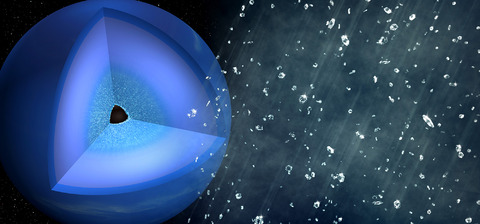Scientists reveal it’s raining diamonds on Neptune
21 Aug 2017

While the earth has experienced freak rainstorms of fish, frogs and even golfballs, its sister planets Neptune and Uranus routinely produce something altogether more impressive, scientists have revealed.
Researchers in Germany and the United States, assisted by colleagues from Japan and the University of Warwick in the UK, have demonstrated that diamond showers are a regular feature of both worlds.
Dr Dominik Kraus, head of Helmholtz-Zentrum Dresden-Rossendorf (HZDR) junior research group, said the work had simulated conditions inside the cosmic giants more accurately than ever before.
“These chemical processes inside the planet tell us something about its vital properties. This allows us to improve planetary models. As our studies show, previous simulations have not been accurate,” remarked Kraus.
The interior of planets like Neptune or Uranus contain a solid core swathed in thick layers of ‘ice’, which is mostly made up of hydrocarbons, water and ammonia.
No one had been able to directly observe the showers in an experimental setting
Dominik Kraus, head, HZDR junior research group
Previously, astrophysicists hypothesised that the extreme pressure more than 10,000 kilometers beneath the surface of these planets splits the hydrocarbons, causing diamonds to form before sinking deeper into the planet’s interior.
However, “no one had been able to directly observe the showers in an experimental setting”, said Kraus.
Thanks to the ultra-powerful X-ray laser and facilities at the Stanford Linear Accelerator Center (SLAC) in California, the collaborators could observe the fission of hydrocarbon and the conversion of carbon into diamonds in real time.
“In our experiment, we exposed a special kind of plastic – polystyrene, which also consists of a mix of carbon and hydrogen – to conditions similar to those inside Neptune or Uranus,” explained Kraus.
This was achieved by sending two shock waves through the samples, triggered by an extremely powerful optical laser in combination with the X-ray source Linac Coherent Light Source (LCLS) at SLAC.
At a pressure of about 150 gigapascal and temperatures of about 5,000oC, they compress the plastic. As the first smaller, slower wave is overtaken by another stronger second wave, diamonds form the instant these waves overlap.
The process takes only a fraction of a second but could be snapped using ultrafast X-ray diffraction. The experiment revealed that most carbon atoms compact into nanometer-sized diamonds, the scientists revealed in results published in the journal Nature Astronomy.
From their results, the authors extrapolate that diamonds on Neptune and Uranus are much larger structures and likely sink down to the planet core over a period of thousands of years.
Besides HZDR and SLAC participants included the University of California in Berkeley, the Lawrence Livermore National Laboratory, the Lawrence Berkeley National Laboratory, the GSI Helmholtzzentrum für Schwerionenforschung, the University of Osaka, TU Darmstadt, the European XFEL, the University of Michigan, and the University of Warwick.

